- Like
- SHARE
- Digg
- Del
- Tumblr
- VKontakte
- Flattr
- Buffer
- Love This
- Save
- Odnoklassniki
- Meneame
- Blogger
- Amazon
- Yahoo Mail
- Gmail
- AOL
- Newsvine
- HackerNews
- Evernote
- MySpace
- Mail.ru
- Viadeo
- Line
- Comments
- Yummly
- SMS
- Viber
- Telegram
- JOIN
- Skype
- Facebook Messenger
- Kakao
- LiveJournal
- Yammer
- Edgar
- Fintel
- Mix
- Instapaper
- Copy Link
 Structuring Youth Fitness Programs
Structuring Youth Fitness Programs
Just a few decades ago, many people believed that women’s bodies were not as capable as men’s bodies at reaping the benefits of physical training for improved health and athletic performance. Fast-forward to today, and most personal trainers and coaches recognize that women stand to improve athletic abilities and health from focused exercise and training, as much, if not more so, than men.
I suggest that a similar evolution of thought will soon be making its way through youth performance training, where it’s just a matter of time before parents and coaches will come to realize that kids can greatly improve their health and athletic performance through proper and early training. By focusing on the right exercises early, kids can improve athletic performance, build coordination, fight obesity, and gain a tremendous amount of confidence. Further, the earlier kids begin to build the proper technique and habits in physical training, the sooner they’ll be able to progress to more challenging and stimulating exercises in their training.
Below are two different lists: the first one is what parents and coaches should be doing more of with their youth performance training, and the second is what they should be doing less of.
The Do’s of Youth Fitness Training
Strength Training
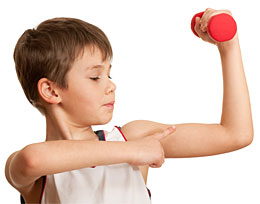 The primary physical attribute that separates an older kid from a younger kid, aside from height and weight, is that older kids are stronger, and this accounts for much of the athletic superiority older kids have over younger kids. Thus, in order for our beginning athletes to get as much out of their abilities as possible, it is of paramount importance that they strength train. Most kids can start weight training as early as seven years old, and weight training is arguably the best means of getting kids ready for sports, improving motor performance,and reducing their chance of injury. When young athletes learn to strength train properly, not only do they improve the integrity of their muscles, connective tissues, nervous system, and cardiovascular system, they also learn how to efficiently move their body in space.
The primary physical attribute that separates an older kid from a younger kid, aside from height and weight, is that older kids are stronger, and this accounts for much of the athletic superiority older kids have over younger kids. Thus, in order for our beginning athletes to get as much out of their abilities as possible, it is of paramount importance that they strength train. Most kids can start weight training as early as seven years old, and weight training is arguably the best means of getting kids ready for sports, improving motor performance,and reducing their chance of injury. When young athletes learn to strength train properly, not only do they improve the integrity of their muscles, connective tissues, nervous system, and cardiovascular system, they also learn how to efficiently move their body in space.
Start with a focus on body weight exercises, and make sure kids master form before adding external resistance (weights). Weight vests, resistance tubes, and medicine balls are great for adding extra weight without changing the technique or dynamics too much. Strength endurance should be the initial focus, followed by phases of strength, then power. The following exercises (and their variations) are a great starting point. Consult a qualified strength coach or personal trainer if you’re not sure of the proper technique, sets, reps, and rest.
- One and two legged squats
- Deadlifts
- Lunges
- Olympic lifts
- Chin-ups and Pull-ups
- Inverted rows
- Push-ups
- Dips
- Sit-ups
- Planks
Further Reading:
Power, Speed, and Conditioning Training
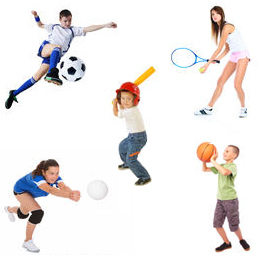 Most organized youth sports are speed and acceleration based (football, volleyball, basketball, baseball/softball, track & field sprints and jumps) where the majority of activities involve short bursts of movement followed by full or complete rest, with some having a bit more speed endurance focus (soccer, lacrosse). Therefore, youth speed training should mostly entail short sprints and change of direction drills of 100 meters or less, with emphasis on acceleration (less than 20 meters), speed (20- 60 meters), and speed endurance (60-100 meters).
Most organized youth sports are speed and acceleration based (football, volleyball, basketball, baseball/softball, track & field sprints and jumps) where the majority of activities involve short bursts of movement followed by full or complete rest, with some having a bit more speed endurance focus (soccer, lacrosse). Therefore, youth speed training should mostly entail short sprints and change of direction drills of 100 meters or less, with emphasis on acceleration (less than 20 meters), speed (20- 60 meters), and speed endurance (60-100 meters).
Plyometrics, when done correctly, can greatly improve an athlete’s speed and power by helping them to produce large amounts of force in less time. Like with strength training, meet with a strength coach or personal trainer if you’re not sure of the proper technique, sets, reps, and rest. An important point for plyometric training, or “jump” training, is that the athlete is in a non-fatigued state where quality is greatly emphasized over quantity. Start with two footed jumps, progressively adding in one footed jumps. Be sure to keep training sessions short and sweet, no more than once or twice a week, with a 20-40 total jumps per session.
Further Reading:
Make Lifestyle Conducive to Performance
 Stay fully hydrated throughout the day, aiming for the child’s weight (pounds) in ounces of water per day.
Stay fully hydrated throughout the day, aiming for the child’s weight (pounds) in ounces of water per day.
Sleep 8-12 hours per night, with regular naps if needed. Kids are growing, and sleep is the best way of supporting that growth.
Focus on whole foods with minimal processing, with an emphasis on high quality meat, vegetables, and good fats. Eat every three to four hours to keep a steady blood sugar and reduce binging.
Snack on mixed nuts and fruit, instead of chips, crackers, and candy bars.
Further Reading:
The Don’ts of Youth Fitness Training
Strength Training Only the Mirror Muscles, Going Too Heavy, and Going Too Light
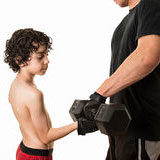 All too often, youth (and commonly male adults) focus exclusively on the “mirror muscles”, those that can be seen in a mirror (chest, biceps), forming an imbalance with the muscles that can’t be seen, or leaving out other muscle groups all together (like the legs). This can lead to postural issues and increased risk of injuries. Upper body pushing exercises (push-ups, bench press, etc.) without an equal amount of pulling exercises (pull-ups, chin-ups, rows, etc.) is a recipe for muscle imbalances of the shoulder and upper back.
All too often, youth (and commonly male adults) focus exclusively on the “mirror muscles”, those that can be seen in a mirror (chest, biceps), forming an imbalance with the muscles that can’t be seen, or leaving out other muscle groups all together (like the legs). This can lead to postural issues and increased risk of injuries. Upper body pushing exercises (push-ups, bench press, etc.) without an equal amount of pulling exercises (pull-ups, chin-ups, rows, etc.) is a recipe for muscle imbalances of the shoulder and upper back.
Going too heavy before a young athlete is ready, can get them hurt or lessen internal motivation. On the flip side, not going heavy enough once s/he is sufficiently prepared, diminishes the potential positive effects and can make training a waste of time.
Over Using Long & Slow Cardio, Doing Plyo Cardio, and Conditioning as Punishment
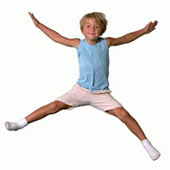 Having athletes do long and slow cardio (LASC) with the hopes of improving speed-based sports performance just doesn’t make sense from a physiological perspective. Unless your child is training for an endurance sport (cross country, cycling, long swimming), then it is much better to focus on work-rest ratios that are closer to the sport at hand. It makes no sense for softball players to get their speed and conditioning training by running multiple miles, just like it would make no sense for a marathon runner to focus their training on one-rep max bench pressing.
Having athletes do long and slow cardio (LASC) with the hopes of improving speed-based sports performance just doesn’t make sense from a physiological perspective. Unless your child is training for an endurance sport (cross country, cycling, long swimming), then it is much better to focus on work-rest ratios that are closer to the sport at hand. It makes no sense for softball players to get their speed and conditioning training by running multiple miles, just like it would make no sense for a marathon runner to focus their training on one-rep max bench pressing.
Further, plyometrics as “cardio” is at best a poor use of time, and at worse the potential cause of tendon, knee, and back injuries. Plyometrics are meant to be performed in a fresh, non-fatigued state so as to stimulate the nervous system and stretch-shortening cycle as much as possible. Doing plyometrics and other jumping when overly tired just teaches the body to be slow and unpowerful, and sets one up for injury.
Lastly, conditioning as punishment is as reasonable as saying “the beatings will continue until morale improves”. As a coach or a parent, conditioning should simply be viewed as a necessary part of sports training that will aid kids in becoming better athletes, and should not be called upon as a form of discipline. When, instead, kids are punished with conditioning, it undermines the overall benefit and purpose of said conditioning, and typically entails a reduced effort and decreased internal motivation on the part of the athletes.
Not Focusing on Lifestyle Factors
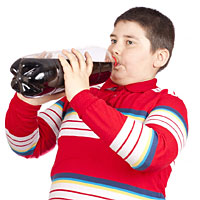 Sugary drinks (like Gatorade), are full of sugar, artificial flavors, and artificial colors. For most activities, water is best. Make sure to hydrate well before practice and games.
Sugary drinks (like Gatorade), are full of sugar, artificial flavors, and artificial colors. For most activities, water is best. Make sure to hydrate well before practice and games.
Soy protein powder is a poor substitute for real protein-based food. Not only can it be an endocrine disruptor, soy protein powder is inferior to whey protein at stimulating protein synthesis.
Candy and other refined foods should not be used to “beef up” skinny kids. All this does is make kids “skinny fat” and sets them up for insulin issues down the road.
Fat and protein should not be omitted in an effort to “trim down” chunkier kids. Being hungry all the time and not getting the proper physical building blocks is a recipe for disaster, and will decrease athletic performance over time.
The Bottom Line
Done properly and with sufficient guidance, multiple forms of exercise training can greatly enhance the physical performance of young athletes. Further, the right kind of training can protect kid’s muscles and joints from sports-related injuries, and strengthen their bones. Appropriate forms of strength training, speed training, and plyometric training, coupled with a healthy overall lifestyle, can have a synergistic effect on youth athletic performance. Through safe and prudent exercise progression, coaches, trainers, and parents can help children and young adults start on the path to improved health and fitness, and become much better athletes along the way.
See Also:
About Jeremy Senn
Jeremy Senn MS, CSCS specializes in body fat reduction & muscular power for increased health & physical performance. Jeremy has worked with hundreds of personal training clients and athletes, has a Masters Degree from Southern Oregon University, and has served as an instructor teaching Physiology of Exercise at SOU. Jeremy is published in MSSE ("Risk of Heart Disease in Firefighters").

